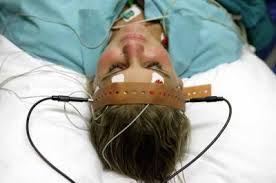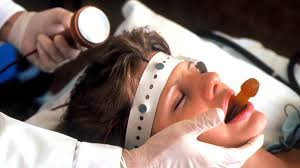Lesson 3: Treatment
Electroconvulsive Therapy
Electroconvulsive therapy (ECT) was developed in the 1930s for use in the treatment of mentally ill people. ECT involves sending an electrical current through the brain at a low voltage. When it was first used, however, the voltage was excessive and almost half of the patients experienced complications (including dislocated joints and broken bones) from being restrained during the violent convulsions that occurred.
Current medical practice of ECT therapy involves anesthetising the patient (making unconscious) then injecting a drug to temporarily paralyze the muscles. In this state, the muscles do not contract during the treatment, thus preventing bone and joint injuries. Electrodes are placed on the scalp and a very small electrical current is passed through the brain. This current produces a seizure that may last from 30 seconds to a minute. About fifteen minutes later, the patient regains consciousness. The patient may experience confusion and have a headache and/or sore muscles for several minutes.
Although psychiatrists do not fully understand why ECT works, they believe the seizures stimulate activity in the synapses between neurons. This activity may restore brain neurotransmitters much like the action of antidepressants. Many health care practitioners prefer to use traditional treatment methods first and suggest ECT only if no improvement in the condition of the patient has resulted. Other psychotherapists actively support banning ECT because they consider it an inhumane and ineffective treatment. One patient, however, credits ECT with improving her life and preventing a potential suicide. Please review her story, summarized from Chatelaine (1998).
|
Läna, a student in university, developed depression part way into her fall semester. The depression became so severe that she considered suicide as an option. She eventually moved back in with her parents and began taking antidepressants prescribed by her doctor. The medication, however, had little effect, and she was hospitalized a few months later. While in the hospital, Läna learned about ECT. Her psychiatrist described the procedure to her and told her that the rate of success was between 60 to 80 percent. She agreed to try ECT and, after about a dozen treatments, began to feel better. In fact, Läna was able to return to school. She earned her degree and now describes herself as happy and energetic. If she were ever to experience severe depression again, Läna commented she would not hesitate to undergo additional ECT sessions. |
Video: How ECT helped a woman with severe depression.
 Although ECT may not be the best treatment for everyone with depression, for severely depressed people who do not respond to antidepressant medications or cognitive therapy, ECT may be the only alternative. Treatment often requires more than six sessions and patients must give consent before beginning this form of therapy.
Although ECT may not be the best treatment for everyone with depression, for severely depressed people who do not respond to antidepressant medications or cognitive therapy, ECT may be the only alternative. Treatment often requires more than six sessions and patients must give consent before beginning this form of therapy.